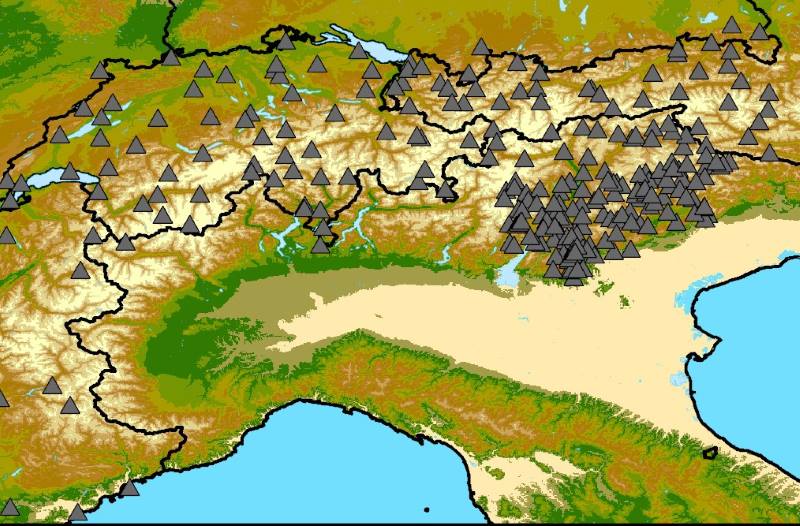Summary:
Short, intense summer rainstorms in the Alps could occur twice as often if average regional temperatures rise by 2°C, according to new research published in npj Climate and Atmospheric Science. These brief but powerful rainfall events, which can trigger flash floods, debris flows, and urban inundation, are already responsible for significant damage when they occur — such as the 2018 downpour that flooded Lausanne with 41 mm of rain in just 10 minutes, causing damages of 32 million Swiss Francs.
In the new study, scientists from the University of Lausanne and the University of Padova analyzed data from 299 high-elevation weather stations across Switzerland, Germany, Austria, France, and Italy. Using a physically-based statistical model, they found that each degree of warming is associated with an approximately 9% increase in the intensity of short-duration rainfall. At 2°C of warming, the probability of extreme rainfall events — those used in infrastructure design and flood risk management — is expected to double. Researchers warn that even a 1°C increase would have serious consequences, with warming already amplifying thunderstorm activity in the Alpine region.
As the Alps warm faster than the global average, the findings point to the urgent need for adaptation measures, especially for vulnerable urban and mountain infrastructure.

Alps could face a doubling in torrential summer rainfall frequency as temperatures rise by 2°C
In June 2018, the city of Lausanne in Switzerland experienced an extreme and short-lived rainfall episode, with 41 millimeters of precipitation falling in just 10 minutes. Large parts of the city were flooded, resulting in estimated damage of 32 million Swiss Francs.
These short, extreme events, often causing severe damage to property and posing risks to lives, are still very rare in Switzerland today. However, with the rise in temperatures caused by global warming, they are likely to become more frequent in the future, particularly over the Alpine mountains and their surroundings. Warm air retains more moisture (around 7% more per degree) and intensifies thunderstorm activity.
As the Alpine region is warming faster than the global average, it is particularly hard hit. It is therefore urgent to assess the impact of global warming in these regions.
In the new study, scientists from UNIL’s Faculty of Geosciences and Environment, in collaboration with the University of Padua (UNIPD) have demonstrated that an average temperature rise of 2°C could double the frequency of short-lived summer rainstorms in the Alpine region. With such warming, an intense storm currently expected every 50 years could occur every 25 years in the future.
To obtain these results, the researchers examined data from almost 300 weather stations in the European Alps, spread across Switzerland, Germany, Austria, France, and Italy. They focused on record-breaking rainfall events (lasting from 10 minutes to an hour) between 1991 and 2020, as well as temperatures associated with these storms.
Based on these observations, a statistical model incorporating physics principles has been developed to establish a link between temperature and rainfall frequency, and then to simulate the future frequency of extreme precipitation using regional climate projections.
“Our results show that an average temperature rise of 1°C would already be highly problematic,” warns Nadav Peleg, researcher at UNIL and first author of the study. “The sudden and massive arrival of large volumes of water prevents the soil from absorbing the excess. This can trigger flash floods and debris flows, leading to infrastructure damage and, in some cases, casualties,” he adds. “It is therefore crucial to understand how these events may evolve with climate change in order to plan appropriate adaptation strategies, such as improving urban drainage infrastructure where necessary.”
Francesco Marra, researcher at UNIPD and one of the main authors of the study adds: “An increase of 1°C is not hypothetical, it is likely to occur in the coming decades. We are already witnessing a tendency for summer storms to intensify, and this trend is only expected to worsen in the years ahead.”
Journal Reference:
Peleg, N., Koukoula, M. & Marra, F., ‘A 2°C warming can double the frequency of extreme summer downpours in the Alps’, npj Climate and Atmospheric Science 8, 216 (2025). DOI: 10.1038/s41612-025-01081-1
Article Source:
Press Release/Material by Laure Anne Pessina | University of Lausanne (UNIL)
Featured image credit: Loris Tissino | Unsplash




